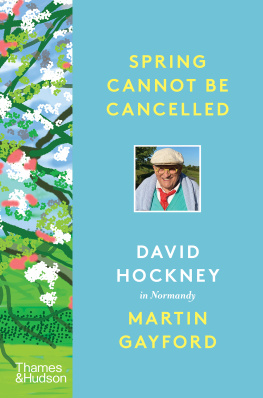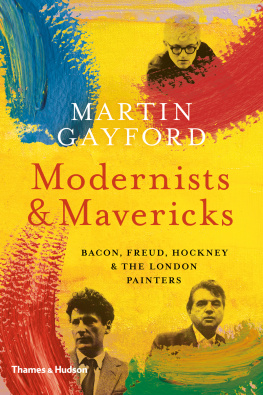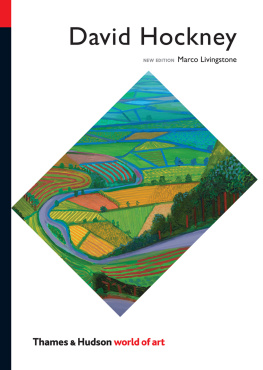
acknowledgments
When it comes to acknowledgments in a book like this, I feel a bit like David with a deck of Polaroids in my hand, getting set to splay out the patternonly, in this case the deck of names spreads out over decades, and the patterns turn in and in on themselves: a four-dimensional kaleidoscope.
For starters, of course, there are the remarkable assistants and more-than-assistants from Hockneys own shop: majordomos Karen Kuhlman, Julie Green, and Gregory Evans; the photographers Richard Schmidt and Jean Pierre Goncalves; the ever hospitable and cheerful Elsa Duarte; and house intellectual (and master detective) David Graves, ever teeming with fresh hunches and insights.
And then, especially during the Looking Glass passion, where would any of us have been without the University of Arizonas optical wizard Charles Falco? Similarly, time and again I found myself turning for guidance and perspective to the Gettys John Walsh; the National Gallerys Arthur Wheelock; and Gary Tinterow and Mike Hearn at the Metropolitan.
I boggle at the number of editors who over the many years have lent their sage counsel to this evolving project, starting at the New Yorker with William Shawn and followed by all three of his successors as editor in chief (Robert Gottlieb, Tina Brown, and David Remnick), as well as my own editors there over the years: John Bennet, Pat Crow, and Jeffrey Frank. Ive lost track of which particular fact checkers there shepherded which particular piece, but I salute the entire incomparable kennel! In addition, I am happy to be able to thank Raymond Foye at the Petersburg Press and Mark Horowitz at Los Angeles Magazine.
At the LA Louver Gallery, Peter Goulds and Elizabeth East were wry and steadfast and always wonderfully supportive.
At the University of California Press, editor Stephanie Fay and her crack trouble-shooter Eric Schmidt lavished steadiness, humor, and grace on what developed into an improbably complicated publishing process, and Sandy Drooker proved as marvelously resourceful a designer as she had been on the Irwin project on which we first collaborated almost thirty years ago (as hard as that is for either of us to credit).
Parts of this book have come into being under the protection of each of my three agentsFlip Brophy, Deborah Karl, and now Chris Calhounand I am more than glad to be able to doff my cap to each of them here.
My endlessly forbearing and put-upon bride, Joasia, forbore all with never-less-than-bemused good cheer, and our daughter, Sara, veritably grew from infancy into adulthood lapped along by these dialogues, the smartest of us all, and the funniest.
And then finally, of course, theres David. My subject and my teacher and in the end my friend. This book owes all to his brimming generosity of spirit and insight, and to his inextinguishable love of life.
CHAPTER 1
cameraworks
STARING DOWN A PARALYZED CYCLOPS
(1983)
Aboard the jetliner that was flying me out to Los Angeles a few months back, I was browsing through a recent book by David Hockney, the forty-six-year-old British-transplant Californian whose newest work I was heading out to see. Or not so much a book as a pamphlet, the artists textual accompaniment to an exhibition hed organized at the National Gallery in London back in 1981. The National Gallery has lately been sponsoring a series of exhibitions under the rubric The Artists Eye, in which contemporary artists are invited to select a group of masterworks from the museums own bounteous collections and to comment on why these particular paintings have been especially important to them. For his turn, Hockney selected a Vermeer, a Piero della Francesca, a Van Gogh, and a Degas. A few years earlier, Hockney had composed a painting of his own (Plate 2) in which he portrayed his friend, the curator Henry Geldzahler, thoughtfully looking at reproductions of these very paintings taped to a screen in his studio, and he now included this work in his small show as well. In his catalogue essay, Hockney celebrated the exquisite richness of the experience of looking at such paintings, especially when compared with the damning poverty of the experience of looking at most ordinary photographs. With a certain irony, he suggested that the only thing photography was much good at conveyingor at any rate, conveying truthfullywas another flat surface, as, for example, in the reproduction of a fine painting. About sixty years ago, he concluded, most educated people could draw in a quite skillful way. Which meant they could tell other people about certain experiences in a certain way. Their visual delights could be expressed.... Today people dont draw very much. They use the camera. My point is, theyre not truly, perhaps, expressing what it was they were looking atwhat it was about it that delighted themand how that delight forced them to make something of it, to share the experience, to make it vivid to somebody else. If the few skills that are needed in drawing are not treated seriously by everybody, eventually it will die. And then all that will be left is the photographic ideal which we believe too highly of.
Hmmm, I remember thinking as the seat belt signs came on and I stowed my satchel for the descent into Los Angeles, that last comment seemed a bit odd, since about the only thing Hockney had been doing in the two years since was taking photographstens of thousands of photographsand it was indeed Hockneys photographic work which this jet, landing, was now delivering me to see.
I rented a car at the airport, drove to my hotel at the base of the Hollywood foothills, deposited my bags, phoned Hockney, and within the hour was driving up Laurel Canyon toward the artists home. At the top of the canyon, the road intersects Mulholland Drive, onto which I now turneda long meandering avenue that casually skirts the crest of the Hollywood Hills, heading west to east, bobbing in and out of canyons where dusty chaparral outcroppings give way to wide valley vistas far below (a drive vividly evoked, as it happens, in one of the last major paintings Hockney had undertaken before being swallowed into his photographic passion (Plate 1). About two miles east of Laurel Canyon, I veered onto Hockneys side street and quickly parked the car. The home where Hockney has been living since 1979 is nestled below street level, and one arrives at the front door by walking down cement steps shaded in foliage. As I rang the doorbell, I could see through a narrow window into the living roomstudioa delirious clutter. Poster boards were leaning against every available vertical, their faces brimming with layers upon layers of photoprints. Hockney was standing in front of a large table, a thick deck of photoprints in his hand, staring down at a poster board collage-in-the-making, lost in thought. Hed posit a print, look at it for a moment, move it over, finger another print a few inches to the side, pick it out of the jumble and relegate it to one of the many piles of photoprints surrounding the board. Then hed revert to his even concentration, his game of photo solitaire, utterly oblivious. I rang the bell again, and again, until finally he looked up, awakened, and came to the door, smiling, to let me in.
Im sorry, he said with genuine concern. Were you waiting here long? His face was friendly and congenial, his round features reemphasized by round glasses (the left frame gold, the right one black). Pyroxide blond hair shagged out from beneath a yellow-and-red checkered cap across which was emblazoned the word C alifornia. He wore a skinny loosened burgundy tie, a red-striped shirt, a green smock, a pair of well-worn gray wool slacks, and black-and-white checkered slippers over mismatched yellow and red socks. He was of average height but, as he led me now through the living room, I noticed that he lumbers along with the comfortable slouch of a tall man. Leaving the entry foyer, I peered down the hallway into the next few rooms, noting how each wall had been painted a different brilliant color. The afternoon sun streamed in, bouncing hue off hue, to simultaneously cooling and luscious effect. Hockney mentioned that the rooms had only recently been painted and then excused himself for a moment, returning to his collage. He made a few more adjustments, lifted another print out of the middle, set it aside, slid in a replacement, and said, There, that will do for the time being. He then looked up and led me out through the sliding glass door onto the shaded blue-painted wood deck.
Next page










